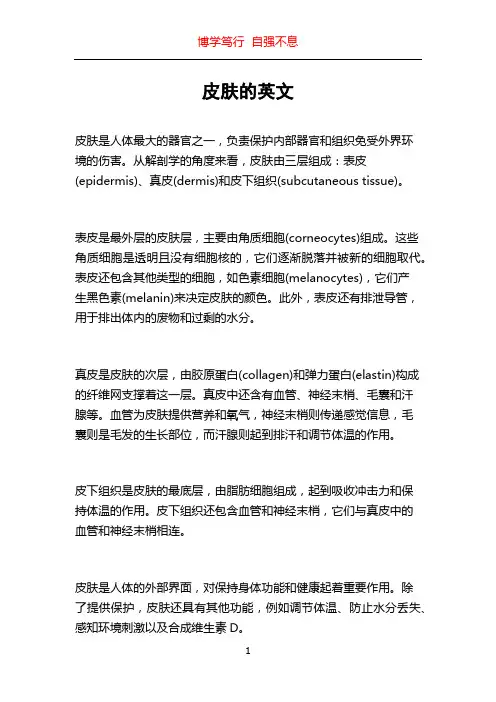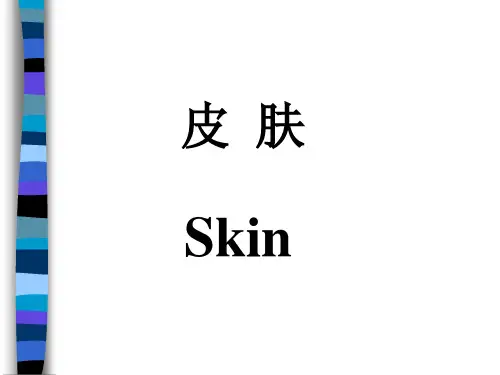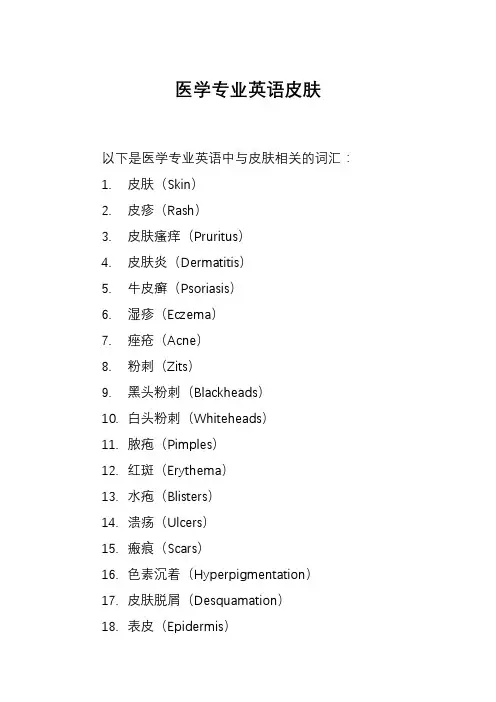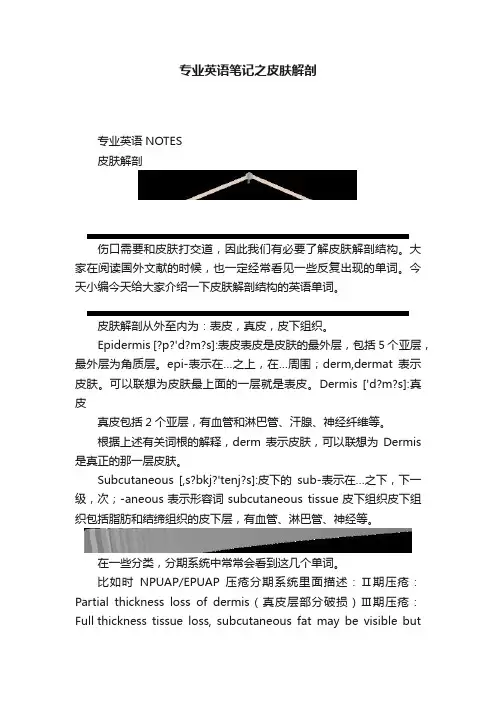解剖学英文皮肤
皮肤的英文

皮肤的英文皮肤是人体最大的器官之一,负责保护内部器官和组织免受外界环境的伤害。
从解剖学的角度来看,皮肤由三层组成:表皮(epidermis)、真皮(dermis)和皮下组织(subcutaneous tissue)。
表皮是最外层的皮肤层,主要由角质细胞(corneocytes)组成。
这些角质细胞是透明且没有细胞核的,它们逐渐脱落并被新的细胞取代。
表皮还包含其他类型的细胞,如色素细胞(melanocytes),它们产生黑色素(melanin)来决定皮肤的颜色。
此外,表皮还有排泄导管,用于排出体内的废物和过剩的水分。
真皮是皮肤的次层,由胶原蛋白(collagen)和弹力蛋白(elastin)构成的纤维网支撑着这一层。
真皮中还含有血管、神经末梢、毛囊和汗腺等。
血管为皮肤提供营养和氧气,神经末梢则传递感觉信息,毛囊则是毛发的生长部位,而汗腺则起到排汗和调节体温的作用。
皮下组织是皮肤的最底层,由脂肪细胞组成,起到吸收冲击力和保持体温的作用。
皮下组织还包含血管和神经末梢,它们与真皮中的血管和神经末梢相连。
皮肤是人体的外部界面,对保持身体功能和健康起着重要作用。
除了提供保护,皮肤还具有其他功能,例如调节体温、防止水分丢失、感知环境刺激以及合成维生素D。
皮肤对温度的调节是通过汗腺和血管收缩扩张来实现的。
当温度升高时,汗腺会分泌汗液使皮肤表面湿润,这样汗液蒸发的过程中可以带走体表的热量。
同时,血管的扩张会导致更多的血液流向皮肤表面,增加体热的散发。
相反,在寒冷的环境下,血管会收缩以减少热量散发,从而保持身体的温暖。
皮肤还起到防止水分丢失的作用。
真皮中的角质层可以阻止水分向外散发,同时汗腺排泄的汗液还含有水分和一些盐类,在皮肤表面形成一层保护膜,防止水分的蒸发。
另一重要功能是皮肤对外界刺激的感知。
皮肤上的神经末梢可以感知温度、触摸、疼痛和压力等刺激,将这些感觉信息传递到大脑中,使我们能够感知和适应外界环境。
此外,皮肤还在体内合成维生素D。
组织胚胎学课件:皮肤

角质层
颗粒层 棘层 基底层
EM:透明角质颗粒无被膜,致密均质 状,角蛋白丝伸入其中。
板层颗粒多,位于胞质周边部,与细 胞膜贴连。所含糖脂等释放到细胞间 隙内,在细胞外形成多层膜状结构, 构成阻止物质透过表皮的主要屏障。
(1)黑色素细胞
是生成黑色素的细胞,在胚胎早期由神 经嵴发生,后迁移到皮肤中。
分布:散布于表皮的基底细胞之间,真 皮中亦有少数。在身体各部的数量有明 显差别,在前额有2000个∕平方毫米,四 肢为1000个∕平方毫米。
LM:特殊染色可显示为有多个较长并有 分支突起的细胞。
EM:丰富的细胞器,主要特点是有多个 长圆形小体—黑素小体。该小体含酪氨 酸酶,可将之转化为黑色素,黑素体充 满色素后成为黑素颗粒。黑素颗粒被输 送至基底细胞内,黑素颗粒棕黑色,是 决定皮肤颜色的重要因素。
(3)梅克尔细胞
散在于毛囊附近的表皮基底细胞间,数 量很少,1个/平方厘米。
LM:特殊染色下为具短指状突起的细胞。
EM:核 较小,不规则,胞质内有许多有 膜的含致密核芯的小泡,与肾上腺髓质 细胞的分泌颗粒相似。
功能:不清楚,可能是感觉细胞,感受 触觉刺激。
真皮
二、真皮(dermis)
EM:游离核糖体丰富,高尔基复合 体,板层颗粒(细胞内含脂质的分泌颗 粒)—直径0.1-0.5μm,有膜包被,内有明 暗相间的平行板层,内容物主要是糖脂和 固醇,主要分布细胞周边并以胞吐的方 式将脂质排放到细胞间隙,形成膜状物。
(3)颗粒层(stratum granulosum)
为 3-5层较扁的梭形细胞组成,位于棘 层上方
【资料】解剖学-英文-皮肤-skin汇编

THE SKIN (cont.)
Dermis Deeper and thicker of the two primary skin layers and
THE SKIN (cont.)
Accessory structures of the skin (cont.)
Skin glands
Sweat or sudoriferous Sebaceous
Sweat or sudoriferous glands
Eccrine sweat glands Most numerous, important, and widespread of the sweat glands Produce perspiration or sweat, which flows out through pores on skin surface Function through life and assist in body heat regulation
Basis of fingerprinting Improves grip for tool use and walking
Dermis
THE SKIN (cont.)
Deeper reticular layer of dermis : filled with network of tough, interlacing, collagenous and stretchable elastic fibers
医学专业英语皮肤

医学专业英语皮肤以下是医学专业英语中与皮肤相关的词汇:1. 皮肤(Skin)2. 皮疹(Rash)3. 皮肤瘙痒(Pruritus)4. 皮肤炎(Dermatitis)5. 牛皮癣(Psoriasis)6. 湿疹(Eczema)7. 痤疮(Acne)8. 粉刺(Zits)9. 黑头粉刺(Blackheads)10. 白头粉刺(Whiteheads)11. 脓疱(Pimples)12. 红斑(Erythema)13. 水疱(Blisters)14. 溃疡(Ulcers)15. 瘢痕(Scars)16. 色素沉着(Hyperpigmentation)17. 皮肤脱屑(Desquamation)18. 表皮(Epidermis)19. 真皮(Dermis)20. 皮下组织(Subcutaneous Tissue)21. 毛发(Hair)22. 指甲(指甲)23. 油性皮肤(Oily Skin)24. 干性皮肤(Dry Skin)25. 敏感性皮肤(Sensitive Skin)26. 油性痤疮(Oily Acne)27. 酒渣鼻(Rosacea)28. 毛周角化病(Keratosis Pilaris)29. 黄褐斑(Melasma)30. 日光性皮炎(Sunburn)31. 晒伤(Sunburned)32. 冻伤(Frostbite)33. 烧伤(Burns)34. 伤口愈合(Wound Healing)35. 瘢痕形成(Scarring)36. 皮肤老化(Skin Aging)37. 光老化(Photoaging)38. 皮肤癌(Skin Cancer)39. 基底细胞癌(Basal Cell Carcinoma)40. 鳞状细胞癌(Squamous Cell Carcinoma)41. 黑色素瘤(Melanoma)42. 皮肤移植(Skin Transplantation)43. 皮肤活检(Skin Biopsy)44. 激光治疗(Laser Therapy)45. 光子嫩肤(Photorejuvenation)46. 强脉冲光治疗(Intense Pulsed Light Therapy)47. 化学剥脱(Chemical Peels)48. 果酸换肤(Alpha-Hydroxy Acids Peels)49. 磨皮治疗(Dermaplaning)50. 皮肤保湿剂(Skin Moisturizers)51. 防晒霜(Sunscreen Creams)52. 去角质剂(Exfoliants)53. 治疗药物(Therapeutic Agents)54. 非处方药(Over-the-Counter Medications)55. 内分泌失调(Endocrine Disorders)56. 系统性疾病(Systemic Diseases)57. 环境因素(Environmental Factors)58. 个人因素(Individual Factors)59. 社会因素(Social Factors)60. 不良生活方式(Unhealthy Lifestyles)。
解剖生理学-皮肤

3.梅克尔细胞merkel cell
位置:位于表皮基底细胞之间。 LM:具有短指状突起。 EM:胞质含有致密核芯的小泡,细胞底 部与盘状的感觉神经末梢接触。 功能:不明,可能感受触觉。 来源:原始的表皮细胞
• 二、真皮dermis
• 真皮由致密结缔组织组成。分为两层: (一)乳头层papillary layer (二)网织层reticular layer
(一)表皮的分层与角化
1.基底层stratum basale 2.棘层stratum spinosum 3.颗粒层stratum granulosum 4.透明层stratum lucidum 5.角质层stratum corneum
(二)非角蛋白形成细胞
1.黑素细胞melanocyte
• 位置:位于基底细胞之间 LM:胞体圆形,突起伸入基底层和棘层, 胞质内含有黑色素。 EM:胞质中有椭圆形小体,称黑素体, 内含酪氨酸酶,能将酪氨酸酶转化为黑色 素。 功能:产生黑色素 来源:神经嵴
2.郎格汉斯细胞langerhans cell
位置:位于棘层
LM:具有树枝状突起。 EM:胞核呈不规则形或分叶形,胞质内含有特殊的 伯贝克颗粒,切面呈网球拍状或杆状,内有一条纵行 的致密 功能:抗原呈递细胞 来源:骨髓
• 2.顶泌汗腺:又称大汗腺,位于腋窝、乳晕、 肛门周围。腺腔大,分泌物粘稠,被细菌分解 后产生特别的臭味,称狐臭。
(二)立毛肌(arrector pili muscle) 是一束斜行的平滑肌,一端附着于毛囊,一端止 于真皮乳头层。
(三)皮脂腺sebaceous gland: 泡状腺
1.腺泡 2.导管
• (四)汗腺sweat gland:
• 单管状腺 • 1.局泌汗腺:又称小汗腺
专业英语笔记之皮肤解剖

专业英语笔记之皮肤解剖专业英语NOTES皮肤解剖伤口需要和皮肤打交道,因此我们有必要了解皮肤解剖结构。
大家在阅读国外文献的时候,也一定经常看见一些反复出现的单词。
今天小编今天给大家介绍一下皮肤解剖结构的英语单词。
皮肤解剖从外至内为:表皮,真皮,皮下组织。
Epidermis [?p?'d?m?s]:表皮表皮是皮肤的最外层,包括5个亚层,最外层为角质层。
epi-表示在…之上,在…周围;derm,dermat表示皮肤。
可以联想为皮肤最上面的一层就是表皮。
Dermis ['d?m?s]:真皮真皮包括2个亚层,有血管和淋巴管、汗腺、神经纤维等。
根据上述有关词根的解释,derm表示皮肤,可以联想为Dermis 是真正的那一层皮肤。
Subcutaneous [,s?bkj?'tenj?s]:皮下的sub-表示在…之下,下一级,次;-aneous表示形容词subcutaneous tissue皮下组织皮下组织包括脂肪和结缔组织的皮下层,有血管、淋巴管、神经等。
在一些分类,分期系统中常常会看到这几个单词。
比如时NPUAP/EPUAP 压疮分期系统里面描述:Ⅱ期压疮:Partial thickness loss of dermis(真皮层部分破损)Ⅲ期压疮:Full thickness tissue loss, subcutaneous fat may be visible butbone, tendon or muscle are not exposed(全皮层破损,可见皮下脂肪,但是骨骼,肌腱或肌肉未暴露)又比如对伤口进行分类时:Partial-thickness wounds involve the epidermis and extend into, but not through, the dermis.部分皮层伤口涉及表皮破损,也可能损伤真皮,但没有穿透真皮。
Full-thickness wounds penetrate through the fat and involve muscle, tendon, or bone.全皮层伤口穿透脂肪,可涉及肌肉,肌腱或者骨骼暴露。
人体表面解剖学
人体表面解剖学
人体表面解剖学(Superficial Anatomy)是一门研究人体外部形态的分支学科。
它既包括查看外部解剖标志物,又包括观察外部解剖结构。
主要涉及人体皮肤、淋巴结、血管、肌肉和关节等解剖结构的研究。
就研究的内容而言,它包括四大部分:1.解剖结构的形态学和位置学;
2.描述解剖结构;
3.识别解剖结构;
4.探索解剖结构间的关系。
首先,人体表面解剖学涉及解剖结构的形态学和位置学。
解剖学的形态学涉及变化的形状,在解剖学中,身体的形状由什么决定,它如何与其他解剖结构相互作用,这些问题都是形态学所考虑的。
解剖学的位置学涉及各种解剖结构在身体上的位置,它决定了解剖结构如何依附在身体上,例如淋巴结在何处,肌肉在哪里,血管在哪里等等。
其次,人体表面解剖学涉及描述解剖结构。
描述解剖结构是指描述解剖结构的形状、位置、功能等方面,使解剖结构之间的关系更加清晰。
它是为了更好地理解解剖结构的形状、位置和功能,使解剖结构之间的联系更加清楚明白。
然后,人体表面解剖学涉及识别解剖结构。
通过查看外部解剖标志物,观察外部解剖结构,使医生能够识别出解剖结构的形状、位置和功能。
最后,人体表面解剖学涉及探索解剖结构间的关系。
解剖学研究人体各部位的解剖结构之间的关系,以及解剖结构与人体其他系统之间的关系,例如神经解剖结构、血液解剖结构、呼吸系统解剖结构等,这些解剖结构的关系是学习人体解剖学的基础。
总之,人体表面解剖学是一门研究人体外部形态的分支学科,涉及查看外部解剖标志物、观察外部解剖结构、描述解剖结构、识别解剖结构以及探索解剖结构间的关系等内容,是掌握人体解剖学的基础。
Anat of Skin 皮肤解剖学
Rich Callahan MSPA, PA-C ICM I Summer 2009
Before Pathophysiology Comes Anatomy • One of the keys to your knowledge of skin disease is understanding the anatomy of the skin and the particular way a given skin disease affects it. • Anatomy of skin also important during dermatologic procedures like skin biopsy, excisions and ED&C.
First line of defense is the stratum corneum, which is primarily composed of laminated keratin.
Definition of Keratin (From Taber’s Medical Dictionary) • “A family of durable protein polymers that are found only in epithelial cells. They provide structural strength to skin, hair and nails. The fibrous protein is produced by keratinocytes.” • Thoroughly understanding the process of keratinization which takes place in the epidermis will unlock answers for many skin diseases because so many of them are disorders of it.
医学英语——常用解剖术语
1、总论[Introduction] superior[上] inferior[下] Cranial[头侧] Caudal[尾侧] anterior[前] posterior[后] ventral[腹侧] dorsal[背侧] medial[内侧] lateral[外侧] internal[内] external[外] superficial[浅] profundal[深] proximal[近侧] distal[远侧] ulnar[尺侧] radial[桡侧] tibial[胫侧] fibular[腓侧] 2、运动系统[locomotor (kinetic) system] vertebrae[椎⾻] cervical vevtebrae[颈椎] thoracic vertebrae[胸椎] lumbar vertebrae[腰椎] sacrum[骶⾻] sternum[胸⾻] rib[肋⾻] thoracic cage[胸廓] skull[颅] frontal bone[额⾻] parietal bone[顶⾻] sphenoid bone[蝶⾻] ethmoid bone[筛⾻] mandible (submaxilla)[下颌⾻] maxilla (supermaxilla)[上颌⾻] nasal bone[⿐⾻] coronal (sagital, lambdoid) suture [冠状(⽮状,⼈字)缝] orbit[眶] clavicle[锁⾻] scapula (shoulder blade)[肩胛⾻] sternum (breast bone)[胸⾻] manubrium sterni (presternum)[胸⾻柄] midsternum[胸⾻体] xiphoid[剑突] humerus[肱⾻] radius[桡⾻] ulna[尺⾻] carpal bone[腕⾻] metacarpal bone [掌⾻] phalanges[指(趾)⾻] hip bone[髋⾻] ilium[髂⾻] ischium [坐⾻] pubis[耻⾻] femur [股⾻] patella[髌⾻] tibia[胫⾻] fibula [腓⾻] articulation[关节] ligament[韧带] flexion[屈] extension[伸] adduction[收] abduction[展] pronation[旋前] supination[旋后] circumductoin[环转] vertebral column[脊柱] intervertebral disc[椎间盘] temporal-mandibular joint[颞下颌关节] shoulder joint[肩关节] elbow joint[肘关节] radiocarpal joint[肩关节] radiocarpal joint[桡腕关节] pelvis[⾻盆] hip joint[髋关节] knee joint[膝关节] ankle joint[踝关节] muscle [肌⾁] tendon[肌腱] fascia[筋膜] tendinous sheath[腱鞘] trapezius[斜⽅肌] latissimus dorsi[背阔肌] sternocleidomastoid[胸锁乳突的] scalenus [斜⾓肌] pectoralis major[胸⼤肌] intercostales[肋间肌] diaphragm[膈肌] inguinal canal[腹股沟管] masseter[咬肌] temporalis[颞肌] deltoid[三⾓肌] biceps brachii[肱⼆头肌] triceps brachii[肱三头肌] axillary fossa [腑窝] gluteus maximus[臀⼤肌] quadriceps femoris[股四头肌] triceps surae[⼩腿三头肌] femoral triangle[股三⾓] 3、内脏[Viscera] viscera[内脏] oral cavity[⼝腔] lip[唇] cheek[颊] palate[腭] tooth[⽛] dentes[⽛] tongue[⾆] parotid gland[腮腺] pharynx[咽] esophagus[⾷管] stomach gaster[胃] duodenum[⼗⼆指肠] jejunum[空肠] ileum [回肠] large intestine[⼤肠] caecum[盲肠] vermiform (appendix)[阑尾] colon[结肠] rectum[直肠] anal canal[肛管] dentate line[齿状线] anus[肛门] liver (hepar)[肝] porta hepatis[肝门] gallblader[胆囊] pancreas[胰] nose[⿐] nasal cavity[⿐腔] laryngeal cavity[喉腔] vocal cord[声带] trachea[⽓管] bronchi[⽀⽓管] lung [肺] pulmonary[肺的] pleura[胸膜] mediastinum[纵隔] kidney[肾] renal pilvis[肾盂] ureter[输尿管] urinary bladder[膀胱] urethra[尿道] testis[睾丸] epididymis[附睾] ductus deferens[输精管] spermatic cord[精索] prostate[前列腺] scrotum[阴囊] penis[阴茎] ovary[卵巢] uterine tube[输卵管] uterus[⼦宫] vagina[阴道] clitoris[阴蒂] mamma (breast)[*] mammary papilla (nipple)[*] perineum[会阴] pelvic diaphragm[盆膈] peritoneum[腹膜] omentum[膜] 4、⼼⾎管系统[Cardiovascular system] heart[⼼] capillary[⽑细⾎管] atrium[⼼房] ventricle[⼼室] tricuspid valve[三尖瓣] bicuspid valve[⼆尖瓣] aortic valve[主动脉瓣] pulmonary valve[肺动脉瓣] sinuatrial node[窦房结] atrioventricular node[房室结] atrioventricular bundle[房室束] right/left bundle branch[右/左束⽀] coronary artery[冠状动脉] coronary sinus[冠状窦] pericardium[⼼包] aorta[主动脉] innominate artery[⽆名动脉(头臂⼲)] common carotid artery[颈总动脉] carotid sinus [颈动脉窦] internal(external) carotid artery[颈内(外)动脉] facial artery[⾯动脉] subclavian artery[锁⾻下动脉] mesenteric artery[肠系膜动脉] common iliac artery[髂总动脉] popliteal artery [腘动脉] vena cava [腔静脉] internal jugular vein[颈内静脉] cephalic vein[头静脉] basilic vein[贵要静脉] saphenous vein[隐静脉] lymphatic duct[淋巴导管] thoracic duct[胸导管] lymph node[淋巴结] spleen[脾] sensory organ[感觉器] receptor[感受器] visual organ[视器] eyeball [眼球] cornea[⾓膜] sclera[巩膜] choroid [脉络膜] ciliary body[睫状体] iris[虹膜] retina[视膜] optic disc[视神经盘] macula lutea[黄斑] aqueous humor[房⽔] lens[晶状体] vitreous body[玻璃体] eyelid [眼睑] conjunctiva[结膜] lacrimal gland[泪腺] vestibulocochlear organ[前庭蜗器] ear( auris) [⽿] auricle[⽿廓] acoustic meatus[⽿道] tympanic cavity[⿎室] tympanic membrane[⿎膜] pharyngotympanic tube [咽⿎管] bony(membranous) labyrinth[⾻(膜)迷路] vestibule [前庭] semicircular canal[半规管] cochlea[⽿蜗] cochlear duct[蜗管] olfactory organ[嗅器] gustatory organ[味器] taste bud[味蕾] central nervous system[中枢神经系统] peripheral nervous system[周围神经系统] visceral nerve[内脏神经医学教.育搜集] afferent nerve[传⼊神经] efferent nerve[传出神经] neuron[神经元] axon [轴突] dendrite[树突] glia [神经胶质] gray matter [灰质] white matter[⽩质] cortex[⽪质] madulla[髓质] nucleus[神经质] ganglion[神经节] fasciculus[神经束] nerve[神经] spinal nerve[脊神经] cervical plexus[颈丛] brachial plexus[臂丛] lumbar plexus[腰丛] sacral plexus [骶丛] phrenic nerve[膈神经] median nerve[正中神经] ulnar nerve[尺神经] radial nerve[桡神经] femoral nerve[股神经] ischiatic nerve[坐⾻神经] common peroneal nerve[腓总神经] cranial nerve[颅(脑)神经] olfactory nerve[嗅神经] optic nerve[视神经] oculomotor nerve[动眼神经] abducent nerve[展神经] facial nerve[⾯神经] vestibulocochlear nerve[前庭蜗神经] glossopharyngeal nerve[⾆咽神经] vagus nerve[迷⾛神经] accessary nerve[副神经] hypoglossal nerve[⾆下神经] autonomic nervous system[⾃主神经] vegetative nervous system[植物神经] sympathetic nerve[交感神经] parasympathetic nerve[副交感神经] spinal cord[脊髓] encephalon (brain)[脑] brain stem[脑⼲] medulla oblongata[延髓] pons [脑桥] mesencephalon[中脑] midbrain[中脑] cerebellum[⼩脑] diencephalon[间脑] thalamus[丘脑] hypothalamus[下丘脑] hypophysis[垂体] telencephalon[端脑] cerebrum[⼤脑] cerebral cortex[⼤脑⽪质] corpus striatum[纹状体] internal capsule[内囊] spinothalamic tract[⽪质脊髓束] medial lemniscus[内侧丘系] lateral lemniscus[外侧丘系] spinal lemniscus[脊髓丘系] trigeminal lemniscus[三叉丘系] suprasternal fossa[胸⾻上窝] supraclavicular fossa[锁⾻上窝] infraclavicular fossa[锁⾻下窝] armpit (axillary fossa)[腋窝] midsternal (midian) line[胸⾻中线(正中线)] anterior midian line[前正中线] parasternal line[胸⾻旁线] midclavicular line[锁⾻中线] mammillary (nipple, milk) line[乳线] posterior (mid-, anterior) axillary line[腋后(中,前)线] scapular line[肩胛线] midspinal line[脊柱中线] dorsomedian line[后正中线] linea paravertebralis [脊椎旁线] the left (right) upper abdomen (quadrant)[左(右)上腹] epigastrium[上腹部] the middle abdomen[中腹部] the lower abdomen[下腹部] linea pararectalis[腹直肌旁线] anterior superior spine[髂前上棘] symphysis pubis (symphysion)[耻⾻联合] ischial tuberosity[坐⾻结节] groin (inguen)[腹股沟] popliteal fossa[腘窝] upper extremity(limb)[上肢] lower extremity(limb)[下肢] posterior superior spine[髂后上嵴] anterior (dorsal) part of chest(前(后)胸部) scapular region[肩胛区] anterior (posterior) fontanelle[前(后)囱]。
《皮肤的结构PPT课件
皮 脂 腺
3. 皮脂的成分 甘油三酯(占50%) 甘油二酯 胆固醇 蜡酯 鲨烯 并含有棒状杆菌. 酵母菌. 螨虫等
皮 脂 腺
4. 皮脂的功能 a. 润泽毛发 b. 润滑皮肤
c. 防止皮肤水分蒸发
d. 使皮肤呈弱酸性,抑制杀灭细菌
皮 脂 腺
5. 皮脂的分泌过程
腺体细胞内充满大量的脂质微滴,腺
细胞破碎后释出脂质团块,与细胞碎片结合 组成皮脂,经过在毛囊上1/3处的开口进入 毛囊,再由毛囊排至皮肤表面。
隆起的称为皮嵴凹下的称皮沟皮沟和皮嵴组成指纹受遗传因素决定其形状因人而异各不相同终生不变皮肤的解剖学皮肤的解剖学其间有血管淋巴管神经和肌肉皮肤附属皮肤表皮真皮皮下组织皮肤的组织学皮肤的组织学由2种细胞构成1角质形成细胞2非角质形成细胞表皮表皮epidermisepidermis表皮来源于外胚层是皮肤中最薄的一层厚00715mm
• • • • •
4、具有: ①抵御外界冲击力 ②支撑皮下组织 ③储存水、电解质及血液 ④有调节体温的作用。
四、皮下组织:了解 (Subcutaneous tissue)
皮下组织 (subcutaneous tissue)
• 又称皮下脂肪层
• 由疏松结缔组织和脂肪小叶构成;
• 此层还分布有汗腺、毛根、血管、淋巴管 和神经。
1.黑素细胞
• 是生成黑素的细胞,位于基底层,来源于外胚叶的神 经嵴,以后移至皮肤中,分散至基底细胞之间,约占基底 细胞的10%。此外,可见于毛发、粘膜、眼色素层和软脑 膜等处。在暴露部位的皮肤、乳晕、腋窝、生殖器及会阴 区较多。其功能是产生黑素。每个黑素细胞借助树枝状突 起伸向邻近的基底细胞和棘细胞,输送黑素颗粒。每个黑 素细胞的树枝状突起大约可与10~36个角质细胞相接触, 形成一个表皮黑素单元。 • 黑素颗粒进入角朊细胞后象伞样聚集于细胞核顶上方,起 到吸收和遮档紫外线,保护基底层,保护细胞核免受辐射 损伤。日光照射可促进黑素的生成。黑素的多少决定了皮
- 1、下载文档前请自行甄别文档内容的完整性,平台不提供额外的编辑、内容补充、找答案等附加服务。
- 2、"仅部分预览"的文档,不可在线预览部分如存在完整性等问题,可反馈申请退款(可完整预览的文档不适用该条件!)。
- 3、如文档侵犯您的权益,请联系客服反馈,我们会尽快为您处理(人工客服工作时间:9:00-18:30)。
called shaft Arrector pili —specialized smooth muscle that produces
Stratum corneum— outermost layer of keratin-filled cells
THE SKIN
Skin pigment—deepest epidermal layer is responsible for production of pigment, which gives color to the skin The brown pigment melanin is produced by specialized cells in this layer (melanocytes)
composed largely of connective tissue
Upper papillary layer of dermis characterized by parallel rows of tiny bumps called dermal papillae
Ridges and grooves in dermis form pattern unique to each individual
THE SKIN (cont.)
Accessory structures of the skin
Hair Soft hair of fetus and newborn is called lanugo Hair growth requires epidermal tubelike structure
Stratum germinativum—inner layer of cells that continually reproduce; new cells move toward the surface As cells approach the surface, they are filled with a tough, waterproof protein called keratin; eventually cells flake off
Dermal-epidermal junction—specialized area between two skin layers Blisters can caused if this junction is damaged or destroyed
THE SKIN (cont.)
Dermis Deeper and thicker of the two primary skin layers and
Number of elastic fibers decreases with age and contributes to wrinkle formation
Dermis also contains nerve endings, muscle fibers, hair follicles, sweat and sebaceous glands, and many blood vessels
“goose bumps” and causes hair to stand up straight
THE SKIN (cont.)
Accessory structures of the skin (cont.)
Receptors Specialized nerve endings—make it possible for skin
Basis of fingerprinting Improves grip for tool use and walking
Dermis
THE SKIN (cont.)
Deeper reticular layer of dermis : filled with network of tough, interlacing, collagenous and stretchable elastic fibers
to act as a sense organ Tactile (Meissner’s) corpuscle /Merkel cell—capable
of detecting light touch Close to the skin surface Pacini corpuscle—capable of detecting pressure Located deep in the dermis Free nerve endings –pain Krause end bulbs (bulboid corpuscles) – lowfrequency vibration
Байду номын сангаас
THE SKIN (cont.)
Accessory structures of the skin (cont.)
Nails Produced by epidermal cells over terminal ends
of fingers and toes Visible part is called nail body Root lies in a groove and is hidden by cuticle Crescent-shaped area nearest root is called lunula Nail bed may change color with change in blood flow
The Integumentary System and Body Membranes
THE SKIN
Structure —two primary layers called epidermis and dermis Epidermis Outermost and thinnest primary layer of skin Composed of several layers of stratified squamous epithelium
